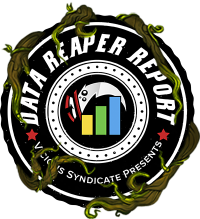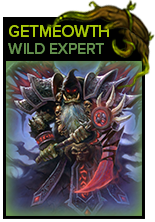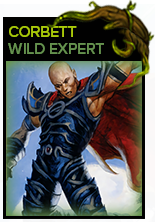
Welcome to the 27th edition of the Wild Data Reaper Report!
The data presented in this article was collected since the most recent set of nerfs to Jandice Barov, Sword of the Fallen, Pen Flinger, Deck of Lunacy, Far Watch Post, and Mor’shan Watch Post.
Contributing to the Data Reaper project through Hearthstone Deck Tracker or Firestone allows us to perform our analyses and to issue the weekly reports, so we want to wholeheartedly thank our contributors. Without the community’s contributions, there would be no project. Contributing data is very easy, so if you enjoy our content and would like to make sure it remains consistent and free – Sign up!
Quick Links
Class/Archetype Distribution | Matchup Winrates | vS Power Rankings | Meta Score | Class Analysis & Decklists | How to Contribute | Credits
Number of Games
| Overall | 220,000 |
| Legend | 52,000 |
| Diamond 4 to 1 | 40,000 |
| Diamond 10 to 5 | 36,000 |
| Platinum | 29,000 |
| Bronze/Silver/Gold | 63,000 |
Class/Archetype Distribution
[TABS_PRO id=47165]
Regardless of where you are on ladder, Mage is defining your meta. On the climb to legend from the high diamond bracket, Mage peaks at a 30% play rate. Secret and APM Mage are the most common archetypes you’ll run into, with Reno Mage occasionally showing up. Secret Mage tends to be more popular on the climb, but once you reach legend, the script is flipped and APM Mage becomes the most popular archetype. Both decks display the #1 and #2 play rates across all rank brackets.
The next most popular class in the meta is Priest, with its familiar two archetypes remaining the common choices: Reno Priest and Big Priest.
Paladin has traditionally been a single-archetype class for a while, but the combination of nerf reversions and the release of some powerful new cards from Forged in the Barrens has brought Paladin back to displaying multiple competitive archetypes. One of the emerging archetypes is Tax Paladin. This deck shook up the meta upon the release of Barrens but was quickly hit with the collateral damage of Sword of the Fallen and Watch Post nerfs. The other is Handbuff Paladin, which is beginning to gain more traction at legend. Joining the newcomers, we find the Wild staple of Odd Paladin.
Speaking of diversity, Warlock is unmatched in that regard. Reno Warlock maintains its relatively higher play rate in and outside of legend, while Darkglare Warlock’s popularity is fringe, but picks up a bit at legend. A newcomer is also breaking into the ranks in Cute Warlock. The deck has a similar play pattern to Aggro Druid with even bigger swing turns.
Shaman in Wild has been saved by Forged in the Barrens, and by saved, we mean that one archetype is finally looking relevant. Murloc Shaman got a complete rework, changing approximately a third of the cards in the deck, upping the power level of the fish tribe, and rising in popularity as a result.
Druid seems stagnant. Celestial Alignment Combo Druids see quite a bit of play but haven’t been widely successful. Aggro, Jade, and Token Druids remain on the periphery of the meta.
Forged in the Barrens and the new Core Set brought about some upgrades to Pirate Warrior and some strong additions to the Rush and Galakrond archetypes; However, Warrior only possesses Pirate Warrior as a moderately popular archetype.
Rogue has fallen from grace. Nitroboost Poison was nerfed before the expansion’s launch, a significant hit to Kingsbane and Odd Rogue. Then came the nerf reversions and a new expansion, which brought about huge buffs to Paladin decks of all kinds. In general, Paladin is a counter to Rogue since Rogue struggles to contest the early board dominance of Paladin. This has led to Rogue significantly decreasing in play.
Hunter and Demon Hunter continue to see very little play at higher ranks, with neither class receiving much help from the nerf reversions and Forged in the Barrens not providing much help to two classes that drastically needed it in Wild.
[TABS_PRO id=47166]

[TABS_PRO id=47167]
vS Meta Score
[TABS_PRO id=47168]
The Wild meta has gone through a big overhaul, and the outcome is a brand-new deck that debuts at the top of Tier 1, and it isn’t even close. Handbuff Paladin is the best deck in the format and is one of the most broken decks we’ve ever seen. It has favorable to even matchups across the board into everything but Big Priest. The rush package dominates aggressive matchups. The draw engine alongside buffed chargers and conviction gives the deck an absurd amount of burst against slower decks. We’ve had many scenarios in the past where good decks aren’t seeing nearly enough play as they should; However, for a deck this broken, it’s severely underplayed. Some players knew it was strong, but few thought it would be to this dramatic extent.
Perhaps Handbuff Paladin should be considered a Tier S/0 deck, and Tier 1 really starts when we get down to Darkglare Warlock. With potential new inclusions of Tamsin Roame and Arcane Golem, Darkglare Warlock continues to see refinement in combination with more players becoming comfortable with the deck. We can notice that many of Darkglare Warlock’s matchups improve at higher ranks, which is indicative of its high skill ceiling.
Secret Mage remains an extremely powerful deck, looking even more powerful at legend than in Diamond, likely due to the increase in APM Mages at legend. Many of the popular Secret Mage lists are built with this matchup in mind, resulting in Secret Mage’s complete domination of the matchup. This has an important effect on APM’s performance on ladder.
Tier 1 at legend is rounded up by three aggressive decks: Murloc Shaman, Pirate Warrior, and Tax Paladin. Murloc Shaman is a very strong aggressive deck with near unrivaled snowball potential, giving it strong matchups into decks with little interaction with the board such as Druid, APM Mage, or Big Priest. By the same argument, decks with the ability to keep Murloc Shaman off the board, such as Reno Priest and Handbuff Paladin, end up being difficult matchups.
Pirate Warrior is another strong performer but struggles against Reno decks as well as Handbuff Paladin. Tax Paladin is a deck that many players had given up on after the Far Watch Post and Sword of the Fallen nerfs, but even after these balance changes, the deck still looks settled at Tier 1.
Tier 2 is one of the more expansive we’ve seen in a very long time in Wild. There are a wide variety of aggressive decks in Odd Paladin, Odd Demon Hunter, Aggro Druid, Discard Warlock, and the newly emerging Cute Warlock. These decks tend to have similar matchup spreads where they lose to other aggressive decks that can effectively keep them off the board (usually the ones sitting at Tier 1) or decks that run a ton of removal such as Reno Priest.
The rest of Tier 2 contains the original trio of MSG Kabal Reno decks, but they all perform different roles in the game. Reno Mage has risen in strength and popularity largely due to the presence of the secret package of Explosive Runes, Potion of Polymorph, and Ice Block, which can be used to disrupt and delay APM Mage. Reno Priest is the most well-rounded of the three in terms of matchup spread but struggles against the elite duo of Handbuff and Darkglare while requiring a well-timed Mindrender Illucia against APM Mage to stand a chance. Reno Warlock is stronger than Reno Priest in its ability to pick off aggressive decks but loses percentages against anti-control decks such as APM Mage and Darkglare. Perhaps, the biggest thing Reno Warlock has going for it is its favorability into Reno Priest.
We finalize with the most surprising result of the report, which will likely come at odds with current perception. APM Mage is one of the two most popular decks in the format, yet the power level of the deck isn’t looking too great. A polarized matchup spread in combination with the widespread use of strong disruption tools has seen APM Mage’s win rate dip drastically from when it initially burst onto the wild scene. Its oppressive matchup against Secret Mage is simply far too devastating for it to display a consistently strong ladder performance.
We realize that this observed win rate is at odds with how the deck feels to play against, and the negative reaction it creates when it wins games in the manner it does, which is a fair complaint. But, when it comes to its ability to improve through refinement as well as its skill ceiling, an argument that is very likely to pop up in response, our initial impression is that APM Mage does not have enough room to grow and is likely to languish in Tier 3. While we can notice that some of its matchups do improve at higher levels, indicating that APM Mage is certainly a deck that exhibits a steeper learning curve than most, it’s not the kind of outlier that can overcome the meta hostility it’s attracting. Its skill ceiling is not comparable to Darkglare or SN1P Warlock either, which we would consider being the Gold Standard for Wild (and those decks still looked very powerful in metrics).
Class Analysis & Decklists
Demon Hunter | Druid | Hunter | Mage | Paladin | Priest | Rogue | Shaman | Warlock | Warrior
Mage is, without a doubt, the defining class of Wild. At the upper echelons of Diamond, Secret Mage has a play rate that eclipses any other class entirely, with APM Mage not far behind. At legend the roles flip and APM Mage becomes the most widely seen deck. However, popularity doesn’t tell the full story and there’s a game of push-and-pull taking place between the class’ two primary archetypes.
Let’s imagine a world where Secret Mage doesn’t exist. Where hyper-aggression doesn’t exist. Where Loatheb doesn’t exist. Where disruption doesn’t exist. APM Mage looks strong. Now let’s come back to reality.
The player base has been highly hostile and effective in its response to the rise of APM Mage. It’s nearly impossible to maintain a high win rate on ladder when you’re regularly facing a 25-75 matchup, which is exactly the daunting task APM Mages face whenever they queue into a Secret Mage. Outside of this matchup, it’s still a mixed bag for APM Mage. For a combo deck, it does a reasonable job against many aggressive opponents, although they still pose problems. Meanwhile, its highly dominant matchups are not particularly prevalent. APM Mage has been highly influential in the early days of Forged in the Barrens, but under the meta it helped shape, its performance has become lackluster.
As we’ve grown accustomed to seeing, Secret Mage is performing very well with matchups that rarely get much worse than slightly unfavored. The deck excels at punishing jank and has a puncher’s chance against just about everything.
However, Handbuff Paladin is a huge obstacle for the deck to overcome. Since the rise of Secret Mage, this is likely the strongest viable counter to the deck that we’ve seen. Secret Mage is certainly strong, but it’s being buoyed by players simply playing the wrong decks into it.
Finally, there’s Reno Mage. Although overshadowed by the two more common Mage archetypes, Reno Mage is still quite popular and showcases a solid win rate. Players have gravitated back to the Reno-Galaxy build, rather than the Reno-Secret Mage lists. The deck is well-rounded, outside of some notable struggles against Handbuff Paladin and Darkglare Warlock.
There’s nothing particularly new when it comes to Priest, which has been a two-deck class for a significant amount of time. Reno Priest hasn’t changed too much with the expansion release, although the list is becoming increasingly tight with an abundance of potential inclusions. The deck has managed to survive the APM Mage onslaught thanks to Illucia, which often acts as an instant-win button in the matchup.
There have been some attempts to make use of Xyrella in the archetype. Xyrella appears strong when enough support pieces are placed around her, but the question of whether it’s worthwhile to give up these valuable card slots is still up in the air.
Big Priest can only look on in envy, as it faces the reality of an oppressively terrible matchup against APM Mage. However, there is one thing it can brag about! It’s the only deck in the format that has any ability to curb the otherwise unstoppable Handbuff Paladin. Mass Dispel has been popping up more often as a nod to the matchup.
While we understand there may be some waning interest in the archetype, one suggestion potentially worth trying is Desperate Prayer. Although we haven’t been able to gather too much information on the card in Wild, a zero-mana source of healing could be very valuable in several matchups, in addition to its use as a potential stall against Darkglare Warlock.
Reno Warlock is the most popular Warlock deck at all levels of play. There is a variety within builds, with players either pushing towards a Tickatus game plan or a normal, value-centric style. Tickatus doesn’t seem to have much of a benefit right now given how fast the meta skews overall.
Darkglare Warlock remains a very powerful deck in Wild that is notably underplayed considering how good it is. Players are currently flexing between the reverted Arcane Golem, Zephrys, and newly introduced Tamsin Roame.
Cute Warlock is an aptly-named strategy that has emerged on the scene with the introduction of Ritual of Doom, a new Core card that offers a payoff to board flooding decks. The deck runs all the 0-mana “cute minions” that can flood the board alongside the strong draw engine of Hand of Gul’dan, which helps it constantly reload. The play pattern is very similar to Aggro Druid, with explosive early turns, except you have access to Life Tap, something Aggro Druid would obviously love to have.
Disco Warlock has been settled at Tier 2 for a few reports now. Lists are all very close to refined. The only notable difference is whether to run Lakkari Felhound or Wicked Whispers.
Demon Warlock refers to Cube Warlocks that are cutting Cubes and running a pure defensive/disruption package alongside Voidcaller, Skull, and big demons. The main goal behind these builds is to keep up with aggressive matchups on ladder. However, the deck’s performance into aggressive matchups is lukewarm, and it can only beat Reno decks due to its ability to outpace them. Are we finally at the point where Voidcaller is too slow in Wild?
Handbuff Paladin is one of the most broken decks we’ve ever seen. The Grimy Goons were simply playing the long con all along.
The deck’s only unfavorable is against the otherwise weak Big Priest. The mirror is one of its worst matchups. This deck crushes almost everything. Aggro decks are obliterated by jacked rush minions. Slower decks are unable to handle the constant pressure and absurd levels of burst in the mid-game. Loatheb shuts down combos and card draw gives the deck staying power. We repeat: Handbuff Paladin is one of the most broken decks we’ve ever seen, and it is grossly underplayed. Players simply haven’t realized the extent of how disgustingly strong this deck is.
At this stage, the deck has 28 established core cards. Players have tried combinations of Lord Barov, Meanstreet Marshal, Cult Neophyte, Val’anyr, Cariel Roame, and Overlord Runthak in the last slots. Saronite Chain Gang is a relatively untested, but likely a viable option. Ultimately, whatever you decide to use doesn’t matter too much. The important thing is you’ll be playing Handbuff Paladin and will therefore be winning lots of Hearthstone games.
Despite having two cards nerfed in the opening weeks of the expansion, Tax Paladin remains a Tier 1 deck. Tax Paladin can do well into a wide variety of decks, from Darkglare Warlock and Secret Mage to APM Mage and Reno Priest. Its weakness only lies against snowballing aggressive decks.
Most lists that players are using are completely unchanged since the nerfs to Far Watch Post and Sword of the Fallen. If nothing else, Tax Paladin’s performance simply raises questions about the potential of similar shells in Call-to-Arms decks in general.
The consistent and perpetually underplayed Odd Paladin maintains a well-rounded matchup spread, while also excelling at punishing jank decks. Conviction and Knight of Anointment have been major additions to the deck, giving it consistent finishing potential. The rise of Murloc Shaman and Handbuff Paladin coinciding with the decline of Rogue hasn’t been the best news for the deck, but it’s still strong enough to find itself straddling the line of Tier 1.
Shaman was down in the dumps, and then came all the murlocs in Forged in the Barrens, completely revitalizing the archetype in Wild. Murloc Shaman is a straightforward tribal aggressive deck that centers on establishing a board and buffing it to push damage. As a result, it’s extremely favorable into decks that can’t control the board efficiently, such as APM Mage or Big Priest. With the introduction of Firemancer Flurgl and the accompanying interaction with Toxfin alongside Lushwater Scout, Murloc Shaman can swing the board back into its favor once or twice a game, so it has relatively close matchups into decks such as Secret Mage and Darkglare Warlock. It struggles into decks with continued waves of removal, as exhibited by its matchups against Handbuff Paladin or Reno Priest/Warlock.
Even Shaman has historically been a very strong anti-aggressive aggro deck. An inclusion of Flametongue Totem makes the deck theoretically stronger, but Even Shaman is crippled by its Handbuff Paladin matchup as well as its struggles against Reno decks.
Reno Shaman is a deck that’s always attracted a cult-like following, with many players running the deck even though its power level was low. This report shows that this is still the case, as there is no reason to play Reno Shaman other than sheer personal enjoyment. It is buried in Tier 4 and has no redeeming matchups.
Celestial Alignment has taken over the position previously held by Aviana as the de facto combo Druid enabler. Celestial Druid began the expansion as a Giants deck hoping to replicate the success of Naga Sea Witch from years past. Once that iteration failed, experiments with Malygos began.
The Celestial builds of Malygos Druid are far less polarizing than previous versions. In the past, aggressive decks completely dominated the archetype. Now, while Celestial builds certainly aren’t happy to see those matchups, they are more tolerable. Combo Druid decks haven’t been particularly well-positioned for a while, due to how aggressively skewed the format has been, and Celestial Druid finds itself in Tier 3.
Aggro Druid has become a bit of a forgotten archetype since the nerf to Voracious Reader. Arbor Up moving from an experimental card to core inclusion has helped, as it performs very well in Aggro Druid decks despite its 5-mana cost. The deck is a solid option for ladder, without being particularly exceptional.
Every report, we have the task of saying the same thing: Jade Druid is terrible. We’re going infinite! Meanwhile, Token Druid has disappeared. Given its standing in our last report, we would speculate that it’s likely still competitive.
Pirate Warrior is one of the strongest decks in the format, boasting a Tier 1 win rate at all rank brackets. Its strengths and weaknesses are very distinct though, as one of the more polarizing decks on ladder.
Pirate Warrior is very weak against Handbuff Paladin, defensive Warlocks, and Priests. On the flipside, it’s strong against combo decks and all other forms of aggression. Fortunately for Pirate Warrior, this spread is very favorable for modern-day Wild.
Pirate Warrior has felt quite refined since day 1, and the lists that are being played don’t appear to be carrying too much baggage. There are some questions about the total weapon count of the deck. Players may want to experiment with a rush version of the deck instead. In this build, Town Criers and Stonemaul Anchormen replace Bloodsail Deckhands and Outriders Axe. This provides similar amounts of draw and early game, while also allowing the powerful Rokara to be tutored easily. This version is entirely novel and hasn’t been widely experimented with yet.
Other Warrior decks don’t appear too often. Rush Warrior and Galakrond Warrior both attempt to capitalize on Conditioning, like Rush Warrior lists seen in Standard, and are worth further exploration. At this stage we all know the story of Odd Warrior and why it fails to gain traction in the format.
Rogue is a mess right now. The Nitroboost Poison nerf was damaging enough, but the rise of Paladin has only done further damage.
In our last report, two Rogue decks found themselves in Tier 1. The first of these was Kingsbane Rogue, which has since had a dramatic fall from grace. Kingsbane Rogue now makes up just over 1% of ladder and has fallen to Tier 3. The second is Odd Rogue. Odd Rogue has almost vanished from ladder, which certainly isn’t a new story for the archetype.
Mill Rogue only loosely resembles a Hearthstone deck. If Mill Rogue finds itself going even against anything, it’s time to bust out the cigars and start a celebration.
Reno Hunter has seen some niche use as an APM Mage counter over the past few weeks. This is a matchup that starts strong at lower ranks but gets better and better as higher-ranked players build it with this direct matchup in mind. A secret package centered around Snipe and Pressure Plate makes it very difficult for APM Mage to make any sort of play.
Sadly though, this matchup alone isn’t enough to carry the archetype or the class overall. Despite a dominant matchup against the most popular deck at legend, Reno Hunter lands in low Tier 3. Struggles against a wide variety of decks place a hard cap on Reno Hunter’s upside.
Even Hunter can be built to be an even more brutal counter against APM Mage since it can run multiple copies of Snipe and Pressure Plate while having greater early-game pressure. It hasn’t caught on too widely, but we do estimate that it lands in the competitive range of win rates.
The hype surrounding Beast Hunter faded after the first few days of the Starving Buzzard reversion, and while the draw engine certainly seems to have potential, the deck looks like it’s several missing pieces away from making an impact in Wild.
Odd Demon Hunter is better than many players may think, finding itself solidly in Tier 2. While nothing from the expansion has made a splash, Odd Demon Hunter was able to pick up some new tools via the nerf reversions. Leper Gnome and Arcane Golem are both old school aggro staples. Bad Luck Albatross has also become a common inclusion. The bird has dramatically changed the Reno Priest matchup, from a highly unfavored one to something close to even.
We’re seeing some experimentations of Demon Hunter branching out beyond Baku in Wild, making use of some eternal-exclusive synergies. Reno Demon Hunters using N’Zoth, the Corruptor and Death Speaker Blackthorn have been popping up, albeit in a very limited capacity.
Preparing our weekly article requires a significant amount of time and effort from many individuals. We would like to wholeheartedly thank our current Patreons, whose generous donations help us fund computing and server costs.
vS Gold is a new membership plan aimed to support our efforts towards improving our content and data analysis while receiving some bonuses and extra features.
Contributors
Here are all the people that participated in bringing you this edition of the [Wild] vS Data Reaper Report:






















Clicking on D0nkey’s photo takes you to Sentenza’s Twittter instead.